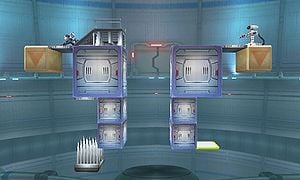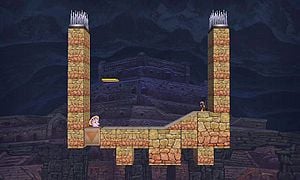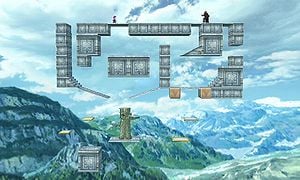Sample stages
Super Smash Bros. Brawl provides three built-in stages which exist as examples of how the Stage Builder works. All three stages can be freely edited by players and changed from their default forms.
While the Sample Stages are just as consistent across every copy of the game as the "regular" stages, and are just as valid to fight on as any other stage, they have never been considered to be part of a tournament legal ruleset. As such, all three of them are banned in tournament play, even without taking their bannable properties into consideration.
Stages
Sample S: Hole
| Sample S: Hole | |
|---|---|

| |
| Universe | Super Smash Bros. |
| Appears in | SSBB |
| Availability | Starter |
| Tracks available | Boss Battle Song 1 |
Sample S: Hole is the small size example. Its layout consists of two main towers with a hole in the middle, owing to its name.
This stage features ledges that characters cannot grab, thus recovery becomes more difficult. Characters should fight to remain on the stage. There is a small moving platform below the right tower, positioned to move between the left and right side. A character, with luck to find the platform at the same side, may use it to recover.
The left side features a spiked pit near the bottom blast line which can be used to stall.
If Olimar uses his Final Smash, End of Day, on this stage, then as his ship descends from the sky, it falls directly through the hole in the center of the stage, and causes Olimar to die. This does not count as a self-destruct; Brawl awards the KO to one of Olimar's opponents. A player who controls Olimar should remember this and stay aware that Olimar's Final Smash is much less useful than normal. The Bulborbs will hurt Olimar's opponents but the ship will not crash into the stage. After Olimar dies and respawns, he may still try to KO his damaged opponents. If Olimar is using his last stock then he should not use his Final Smash, and the same goes for Ike. However, it is possible to be saved by the moving platform in both cases, if the the platform is in the middle. This however, does not work in Ike's favour, as the opponent will also be saved.
A level 9 Wolf will K.O. itself if Player 1 does not move. This is especially useful for completing challenges that require the player to battle a certain number of matches.
Sample M: Bath
| Sample M: Bath | |
|---|---|

| |
| Universe | Super Smash Bros. |
| Appears in | SSBB |
| Availability | Starter |
| Tracks available | Attack |
Sample M: Bath is mainly a U-shape, with the only exits being the top opening and a lone Drop Block on the left side. The right side is slightly elevated. It is the medium size example.
There is a glitch where if Peach uses her recovery move and floats into one of the blocks underneath the stage, she will remain floating until she is hit or the player moves her in another direction.
Sample L: Maze
| Sample L: Maze | |
|---|---|

| |
| Universe | Super Smash Bros. |
| Appears in | SSBB |
| Availability | Starter |
| Tracks available | Skyworld |
Sample L: Maze is the example of a large stage. It is a very complex stage, with many moving platforms and a few Drop Blocks.
The maze structure occupies the upper half of this stage. The top of this structure is a flat roof. When players enter any custom stage, the game likes to spawn characters on the highest part of the stage. Thus when players enter Sample L: Maze, the game spawns everyone of the roof. Unless someone moves down, all fights begin on the roof.
The roof is close to the top blast line, so it is easy to launch characters upward for the KO (and survivors take hoop damage). The flatness of the roof also aids the use of horizontal projectiles, like Falco's Blaster. To escape the roof, a player can drop their character into the maze below. The presence of items may encourage players to leave the roof and visit other parts of the stage.
The maze is the best place for damaged characters, because walls often block attempts to launch them off the stage. Players can try to launch their opponents through the gaps at the top of the maze, or through the gap at the right side. Players can also try to force opponents into the area below the maze.
The most dangerous area of the stage is the lowest part. Below the maze, there are only a few floating platforms; the risk to miss a platform and fall off the stage is most significant. The lower right area contains only a pair of small, moving platforms. If a character rides a Drop Block into this area, it might need to jump accurately onto either of these two platforms to recover from the fall. The tree bark and small platform are very close to the blast line, so one should not stay there for prolonged periods.
Because the lowest part of the stage is so dangerous, players tend to avoid it. However, sometimes characters do go that low, especially if a Smash Ball floats down there.
